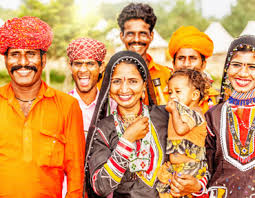|
The impact of Jaipur was very strong. What a place! What people! The massive Pink Fort greeted them from the main road. Hundreds of rickshaws flooded the streets and their coach was surrounded by them. Rajastani men wore huge turbans in brilliant colours, rolled above their heads and matched by the exaggerated moustache that gave them an almost savage appearance. Patti explained that they belonged to the caste of the Rajput warriors in the Hindu religion; they were proud people, courageous and cheerful at the same time. The women wore bright multicoloured skirts that stopped just above their ankles, embroidered with threads of contrasting colours and richly embellished with mirrors and beads. Their legs were adorned with large silver anklets that jingled at every step. The short blouses left their backs bare from the bottom of the shoulder blades down to the waist, while long and light cotton shawls of vivid colours covered their heads, fluttering with every movement and every breath of wind. The colours of the Rajastani clothes were very strong: bright pink, sparkling red, pea green, yellow with the intensity and warmth of the sun; close to each other they filled the eyes with a variety and strength of colour far surpassing those seen in Delhi.
0 Comments
Leave a Reply. |
AuthorBorn in Treviso on the 18th November 1953, Emanuela Cooper studies foreign languages at the College for Tourism in Venice and later Political Science at Padua University. Following a rather extreme existential crisis, towards the end of the 70s, she decides to travel to India ‘to have a look’ and, with any luck, find herself. Made in Nirvana is inspired by the first two trips to India, where Emanuela Cooper returns many times, living there for six years. A big part of the story of Made in Nirvana is based on her personal experience, while the other part is fruit of her vivid imagination. What may appear as invented has probably really happened, and vice versa! Archives
December 2017
Categories |
- Home
- About
- Three Women Lost in London
- Made in Nirvana
- CHAPTERS 12 TO 22
- CHAPTERS 23 TO 33
- LINKS TO BUY
- Contact
- Feedback
- Paintings
- Blog English
- Pagina iniziale
- Biografia... e altro
- SMARRITA A LONDRA
- Contatto
- Made in Nirvana
- CAPITOLI 12 - 22
- CAPITOLI 23 - 33
- Cosa dicono i lettori
- I quadri
- Blog Italiano
- LINK PER L'ACQUISTO
- Link Page
- Home
- About
- Three Women Lost in London
- Made in Nirvana
- CHAPTERS 12 TO 22
- CHAPTERS 23 TO 33
- LINKS TO BUY
- Contact
- Feedback
- Paintings
- Blog English
- Pagina iniziale
- Biografia... e altro
- SMARRITA A LONDRA
- Contatto
- Made in Nirvana
- CAPITOLI 12 - 22
- CAPITOLI 23 - 33
- Cosa dicono i lettori
- I quadri
- Blog Italiano
- LINK PER L'ACQUISTO
- Link Page







 RSS Feed
RSS Feed
